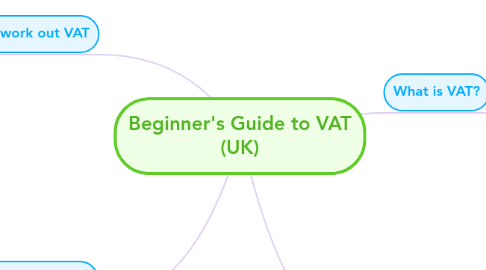
1. How much is VAT?
1.1. There are three different rates:
1.1.1. Standard rate: 20%
1.1.2. Reduced rate: 5 %
1.1.3. Zero rate: 0%
1.2. Most items are standard rate unless they specifically say otherwise.
1.3. Reduced rate applies to certain items such as
1.3.1. domestic fuel and power
1.3.2. installation of energy-saving materials
1.3.3. sanitary hygiene products
1.3.4. children's car seats.
1.4. Zero-rate applies to certain items such as
1.4.1. food
1.4.1.1. except takeaways and restaurants
1.4.2. books and newspapers
1.4.3. children's clothing and shoes
1.4.4. public transport.
1.5. Certain things are exempt from VAT, such as
1.5.1. insurance
1.5.2. providing credit
1.5.3. education
1.5.4. fund-raising events by charities
1.5.5. membership subscriptions
1.5.6. most services provided by doctors and dentists.
2. How you work out VAT
2.1. You have to charge VAT on every sale you make to other business or customers
2.1.1. in other words, you have to add it to the price.
2.2. You do that by multiplying the cost by the VAT rate percentage, then adding that to the cost of the item or service.
2.3. You separate out VAT on receipts, showing the cost (before VAT), the cost of VAT and what rate it was charged at, then the total.
2.4. Most businesses calculate VAT backwards from what they want the total cost to be, to make the total cost a round number.
2.5. You have to keep records of all VAT transactions
2.5.1. That's VAT you've charged on sales and VAT you've been charged on purchases.
2.5.2. Find out more in this guide on how to keep VAT records.
3. For more great mind maps, head to www.Biggerplate.com
4. What is VAT?
4.1. VAT - value added tax
4.1.1. is a tax levied on sales of goods and services.
4.2. Think of it as a tax on the value you add to products and services
4.2.1. in other words, on the price difference between what you've paid and what you charge for a product.
4.3. Not all businesses need to register for VAT.
4.4. If you are VAT-registered:
4.4.1. You pay VAT on the items or services you buy from other business.
4.4.2. You charge VAT on the items or services you sell to other businesses and customer s(if you are VAT registered).
4.4.3. The idea is the VAT you pay and the VAT you charge roughly equals out - if it doesn't, you level the balance with HMRC. That's what your VAT return is for (see below).
5. When do you need to register for VAT?
5.1. You must register if
5.1.1. your turnover in the past 12 months was more than £70,000
5.1.1.1. (the 'VAT threshold' - accurate as of 2010)
5.1.2. You think your turnover will soon be more than £70,000
5.1.2.1. (accurate as of 2010)
5.2. For some small businesses, it can be beneficial to register even if your turnover is less than £67,000 if:
5.2.1. You think it your turnover will soon be over the threshold and want to get the paperwork out of the way now.
5.2.2. You want to seem more professional or assure customers you are a legitimate business, certified by HMRC.
5.2.3. You buy many more items that charge VAT than you sell
5.2.3.1. as your input tax will be much higher than your output tax, and HMRC will reimburse you the difference.
